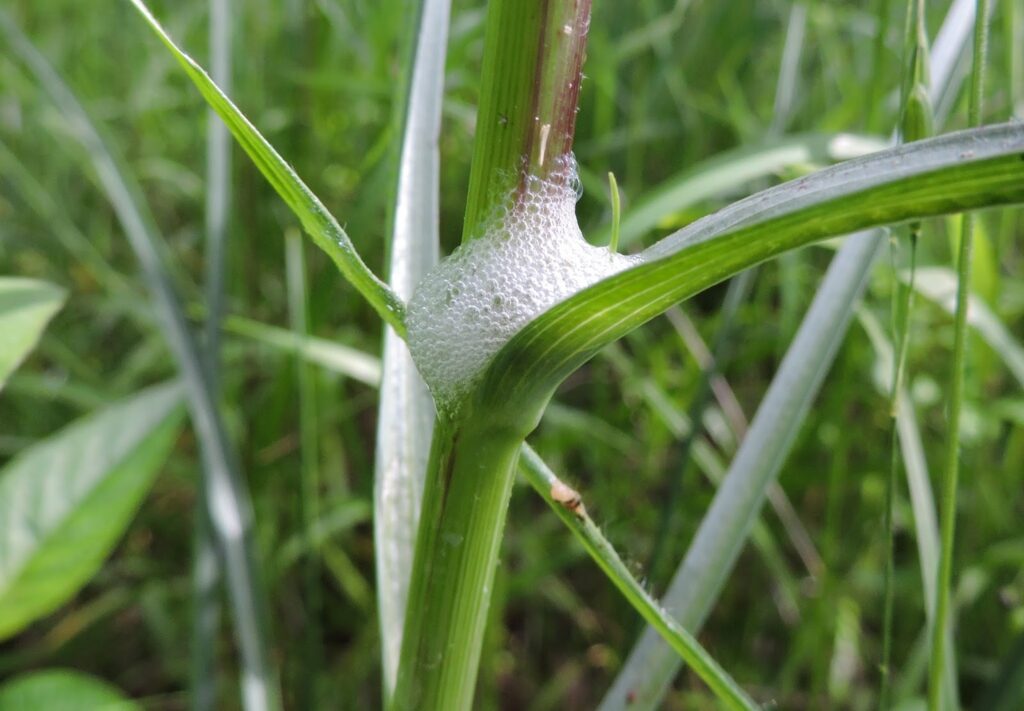The Spittlebug: A Tiny Pest That Can Cause Big Problems in Your Lawn
If you’ve ever walked through your yard and spotted what looks like little blobs of spit on the grass, you’ve likely had a run-in with a spittlebug. While the name might sound funny, these small pests can cause serious damage to your lawn if left unchecked. Let’s take a closer look at the life of a spittlebug, the kind of trouble they bring, and why protecting your lawn from them is important.
What Is a Spittlebug?
Spittlebugs are tiny insects related to leafhoppers. They get their name from the foamy “spit” they leave behind on grass and plants. But don’t worry—it’s not actually spit. The foam is made by the immature spittlebug, or nymph, as a way to hide from predators and stay moist while feeding.
Spittlebugs can be particularly active during the summer months, making it essential to monitor your lawn for signs of these pests. Understanding their behavior will help you take the necessary precautions.
Adult spittlebugs are usually only about 1/4 inch long and can be green, brown, or black. Some have bright red or orange markings on their wings. They can jump surprisingly far for their size and are most active during the warmer months of the year.
The Spittlebug Life Cycle
Spittlebugs go through a few stages in their life:

- Egg Stage: Female spittlebugs lay eggs in the fall, usually in protected spots like the thatch layer of your lawn or on plant stems.
- Nymph Stage: In spring, the eggs hatch into nymphs, which immediately begin sucking juices from grass blades and plant stems. This is when you’ll see those bubbly foam patches.
- Adult Stage: After a few weeks, the nymphs grow into adults. They continue feeding and eventually lay eggs for the next generation.
Most spittlebugs go through just one or two generations per year, but even that can be enough to cause noticeable damage to your lawn.
More information from the Alabama Extension
How Spittlebugs Damage Your Lawn
While one spittlebug might not be a big deal, a heavy infestation can do real harm to your grass and ornamental plants. Here’s how:
Regular inspections can help detect the presence of spittlebugs before they cause significant damage. Early intervention is key to maintaining a healthy lawn vulnerable to these pests.
They may seem small, but their impact on your lawn can be significant if not addressed promptly. Keeping an eye out for these pests can save your lawn.
Grass Damage: Spittlebugs feed by piercing the grass stems and sucking out the sap. This weakens the plant and can lead to yellowing, stunted growth, or even dead patches.
Thatch Buildup: The foam and feeding habits contribute to thatch—the layer of dead grass and roots between the soil and the green grass—which makes your lawn more vulnerable to drought and disease.
Weakened Plants: Besides grass, spittlebugs can also feed on shrubs, flowers, and even crops, weakening them over time.
If you notice patches of thinning grass, yellow streaks, or dry spots despite regular watering, it could be the work of spittlebugs.
Why You Should Protect Your Lawn
A healthy lawn doesn’t just look nice—it also helps control erosion, cool your yard, and improve air quality. Spittlebugs may be small, but their feeding can lead to bigger problems down the road if not managed. Here’s why it’s smart to take action:
By being proactive and recognizing the signs of spittlebugs, you can protect your lawn from their damaging effects.
They Multiply Fast: Spittlebugs lay dozens of eggs, and those nymphs go straight to feeding when they hatch.
Hidden Damage: Their foam hides the feeding activity, so the damage can go unnoticed until it’s widespread.
Taking the time to learn about spittlebugs will empower you as a homeowner, ensuring your lawn remains healthy and vibrant.
Your Lawn Deserves Better: You work hard to keep your yard looking good—don’t let tiny bugs undo all that effort!
How to Deal With Spittlebugs
Here are a few tips to keep your lawn safe:
Mow Regularly: Keeping your lawn well-mowed reduces the hiding spots for eggs and nymphs.
Water Deep, Not Often: Spittlebugs love moist thatch, so avoid frequent shallow watering.
Dethatch When Needed: Breaking up that thick thatch layer helps disrupt their habitat.
Watch for Signs: Look for foam on the grass and yellowing spots. Catching them early is key.
What to do if you have Spittle Bugs: Talk to your lawn care professional about safe treatment options.
Final Thoughts
Spittlebugs may not be the most well-known lawn pests, but they’re definitely worth watching out for. A few patches of foam might seem harmless, but over time, these little insects can turn a healthy green yard into a patchy, stressed mess. With a little awareness and regular lawn care, especially preventative treatments you can stop them before they take over—and keep your grass lush and beautiful all season long.


